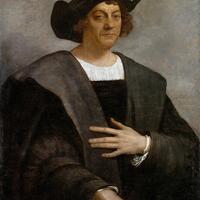More about Portrait of a Man, Said to be Christopher Columbus
- All
- Info
- Shop

Contributor
In a dim, dusty library somewhere, there's at least one lonely graduate student writing a dissertation on all the theories about Sebastiano del Piombo's Portrait of a Man, Said to be Christopher Columbus.
As an art writer, you have to engage with rumors, half-truths, divinations, and legends, but this painting is particularly awash in uncertainty. Although I'll give a brief summary of the contradictory hemmings and hawings of the various Piombo-ologists throughout European history regarding the authenticity of the painting's claim to depict Columbus, I am more interested in this question: why should it be important?
As a child of a "progressive" milieu which taught me that Columbus arrived on the Caribbean shores after the "New World" was already populated with hundreds of civilizations with widely varying customs, I never saw Columbus as a hero. That's right, I said "civilizations," even though they may not have had any use for many of the technologies of the Europeans, even though they were, in some cases, just as violent as the Europeans. Because though some of their practices were shocking to Christians, indigenous nations have systems of ethics which are, in many cases, more civilized than those of Europeans, because they espouse a direct link between generations of people, spiritual forces, and the earth.
Reading various accounts of Piombo's portrait has forced me to confront the fact that, over a century ago, the physical appearance of Columbus was a question of urgent political necessity for U.S. politicians, who sponsored a restoration of both the physical painting and, more importantly, the unlikely story of its authenticity. It was important to have an image of a hero to worship, just as bhaktas hang photos of their gurus and Catholics hang photos of the Pope: without an icon of the man who made the greatest "discovery" in the history of Europe, by bringing the European translations of the Biblical texts, by force, to another continent, it's as though America would have ceased to exist.
At the time, for those politicians, the question of whether the painting was actually an image of Columbus, painted from life by Piombo who was only 21 when Columbus died, was beside the point! At the dramatic conclusion to Bradbury's Fahrenheit 451, the government is searching the streets for an enemy of the state on live television. They can't find the exact person they're looking for, so they find a random hapless person and decide that he's the culprit, for the sake of the viewers. This is basically the same process by which Piombo's image received the awkward passive-voice title "Said to be Christopher Columbus." They used the passive voice because no "experts" wanted to gamble away their reputations on this painting. Whoever the guy in the painting is, he was the right man to play the role of the explorer, whether he wanted it or not. The shoe fit, and, like Cinderella, he has to wear it. The two politicians hired the artist M.E. Chavreau to restore the painting from the collection of the Duke of Talleyrand, and, eventually, finance kingpin J.P. Morgan donated the painting to the Met, implicitly vouching for it.
Around forty years ago, the scholar Michael Hirst would discover that the Latin inscription mentioning Columbus was added long after the painting was finished by Piombo, and that it may be actually be an image of a cleric in Bologna. In 1893, A. Neri had already claimed that the painting was indeed the work of Piombo, because even that is up for debate, but was not an image of Columbus. Néstor Ponce de León, Bernardini, and Thacher all claim that the painting must be a posthumous copy. Contemporaries of Columbus describe his physical features as much different from those of the man in this image, including bright white hair.
But the truth was beside the point, and the jingoist cat was out of the bag. Until the end of art history, this poor anonymous guy will have to carry the burden of "being Columbus" in people's minds. That's his slightly-longer-than-fifteen minutes of fame.
Sources
- Bernardini, Giorgio. Sebastiano del Piombo. Bergamo: Instituto Italiano d'Arti Grafiche, 1908.
- Gardner, Elizabeth E. Italian Paintings: Venetian School: A Catalogue of the Collection of the Metropolitan Museum of Art. New York: the Met, 1973.
- Hirst, Michael. Sebastiano del Piombo. Oxford: Oxford University Press, 1981.
- The Literary Digest, Volume 6. New York: Funk & Wagnalls, 1893.
- Looney, J. Jefferson. The Papers of Thomas Jefferson, Retirement Series, Volume 7: 28 November 1813 to 30 September 1814. Princeton: Princeton University Press, 2011.
- Ponce de León, Néstor. The Columbus Gallery: The "discoverer of the New World" as Represented in Portraits, Monuments, Statues, Medals and Paintings. New York: Ponce de León, 1893.
- Thacher, John Boyd. Christopher Columbus: his life, his works, his remains: as revealed by original printed and manuscript records, together with an essay on Peter Martyr of Anghera and Bartolomé de las Casas, the first historians of America. New York: Pu













